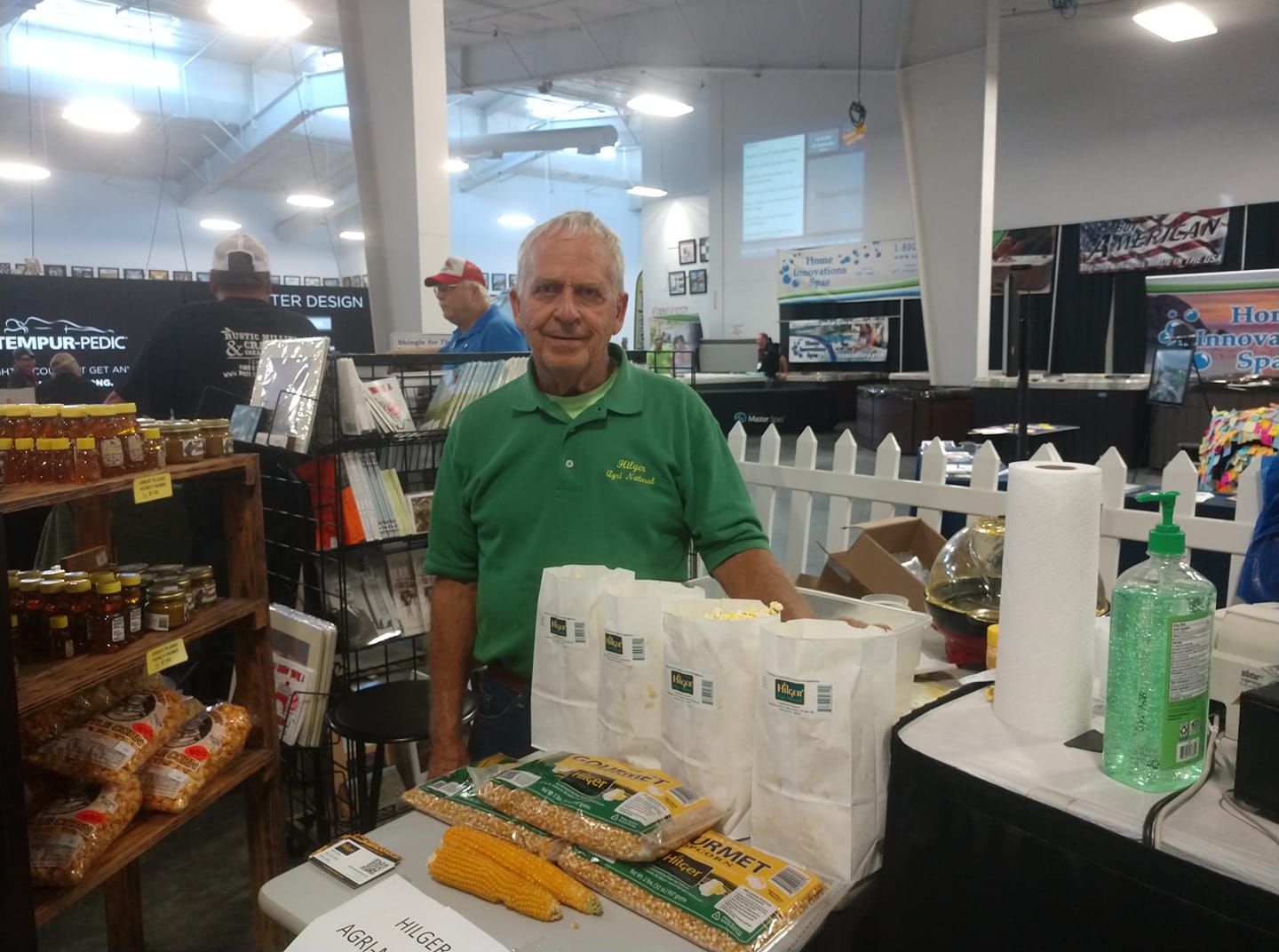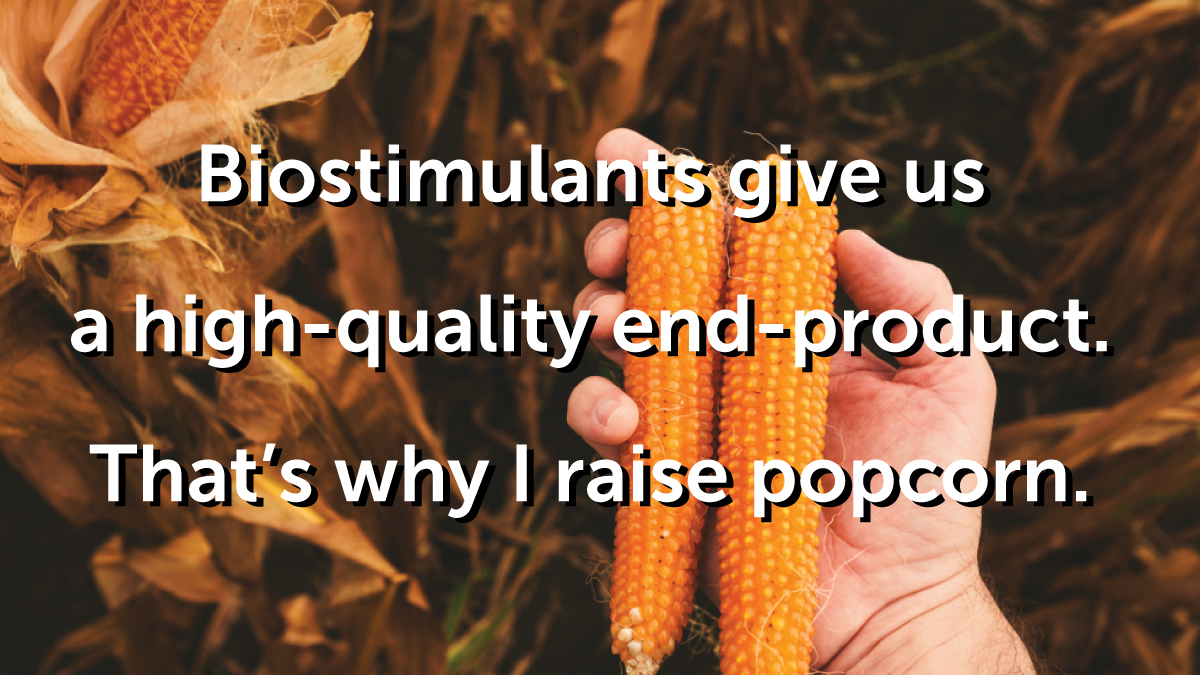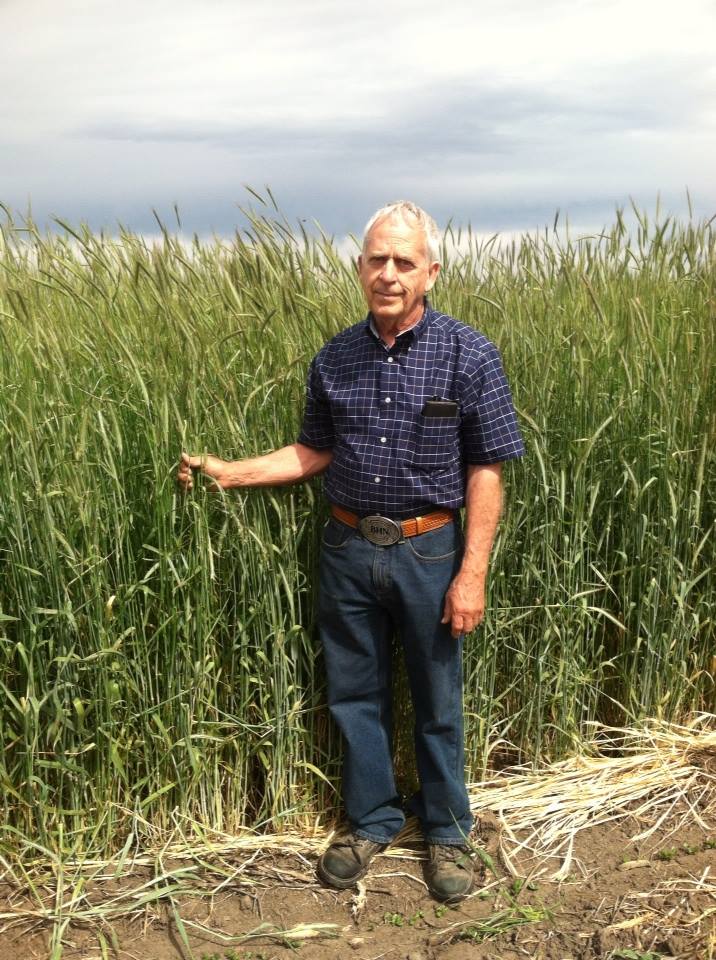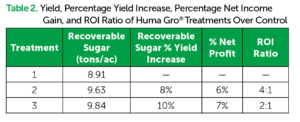
Daniel Hilger at the Nebraska State Fair
An Interview with Nebraska Farmer Dan Hilger
By Jael Batty
Popcorn grower Dan Hilger fights weeds, erosion, flooding, and low commodity prices with an innovative approach that improves his soil health.
The Nebraska farmer applies Huma Gro® products (biostimulants) to his soil to increase soil organic matter. Organic matter stimulates soil biology to break down nutrients and minerals for plant uptake. This keeps Hilger’s crops healthy enough that they naturally resist disease and insect pressure.
In addition to using biostimulants, the popcorn grower has been protecting his crops and the environment by practicing minimum tillage and growing rye cover crops.
In the following interview, we discuss the Nebraska farmer’s innovative approach and the influence that has led him to his current farm methods.
What influences have shaped your farming practices?
Biostimulants Grow a High-Quality Crop

A number of years ago, we raised commercial potatoes. People told us over and over that we had the best-tasting potatoes. Unfortunately, the price of potatoes dropped so low that we couldn’t afford to do it anymore. I got into popcorn because it was shelf-stable, whereas with potatoes, you have a limited amount of time to store them. You can store popcorn and stay in good shape as long as you keep the moisture right and keep the bugs out of it.
The biostimulants give us a high-quality end-product. That’s why I raise popcorn. Because we have better tasting popcorn than anything else on the market.
GMOs Cause Insecticide and Herbicide Resistance
Shortly after I started using biostimulants, GMOs came out. Genetically modified crops have been a big thing over the past 25 years with pesticide-resistant plants and herbicide-resistant crops. A lot of folks thought that was the answer. We could just buy our solution in the seed corn bag and it was going to solve all our problems. Unfortunately, today, we’re seeing a lot of herbicide and pesticide resistance and farmers are scrambling to find a way to control weeds. It’s getting worse every year.
Have they forecast a solution?
The chemical companies come up with different combinations from time to time, but it’s a matter of just 2–3 years before the weeds become resistant to the new stuff. It’s a cycle that’s been happening over the last 50 years or so. A new insecticide comes out and we hear that it’s a whole new chemistry and the bugs won’t develop resistance to it. Four to five years later, the bugs are resistant to it. We’ve been through this over and over and over. It’s one of the reasons I research alternatives.
Tell us about the weed issues you’re solving.
 Cover Crops Control Weed Pressure
Cover Crops Control Weed Pressure
I still use herbicides on soybeans but it’s less effective every year. One of the main reasons I planted rye cover crops is because it helps reduce weed pressure.
Palmer amaranth is a big problem. Redroot pigweed is also a problem. Mare’s-tail has become resistant to herbicides. Herbicides are just not effective on most anything you’ve got out there.
Most guys apply a combination of different herbicides that have different modes of action to try to kill these weeds. That can be quite expensive.
Cover Crops Save Herbicide Costs
Using rye cover crops for weed control saves me the cost of herbicides, and that pays for my rye seed.
It takes a while—three to five years—to get the rye cover crop cycle going to where you’re really seeing a big difference in weed pressure.
If there are any weeds coming up between rows, we can get those with the cultivator.
How do your methods control pests?
Control Nematodes, Rootworms, and Gall Midge
Nematodes are getting to be a bigger and bigger problem here every year. Corn rootworm is an issue. We have a new soybean insect called the soybean gall midge which is getting worse and worse here every year. They’re an insect that overwinters in the grassy borders of the fields. When they come out of the grass in June, they hollow out the soybean stems, which kills the soybeans
Unhealthy Plants Attract Pests
Plants are just like people. If you eat healthy, you’re going to be healthier than if you’re on a junk food diet. Plants that are on an anhydrous ammonia and phosphorus diet are on a junk food diet. They may look green, but they’re definitely not healthy. And the bugs love them. Just like you or me, if we’re not healthy, we’re more susceptible to different illnesses. Plants are the same way. A healthy soil will give you a healthy plant.
Biostimulants and Cover Crops Build Healthy Soils
The biostimulants work hand in hand with cover crops to build healthy soils. They stimulate microbial activity. Then the rye has a live root system in the ground year-round and that’s what microbes like. And the cover crops take advantage of the work the microbes do. So, they’re complementary to each other.
Are you solving other issues?
Reducing Soil Erosion
As well as weeds and pests, erosion is also a serious issue. Statistics show that in the last 150 years, we’ve lost 50% of our topsoil in this country. We can’t keep going down that same road. In another 150 years, there won’t be anything left.
We have to change our practices to reduce erosion.
We used to do a lot of moldboard plowing and chiseling in the fields. We thought we had to do things like chiseling to break up the hardpan. Today most everything is minimum-till or no-till. Things like chiseling lead to erosion and loss of topsoil.
Biostimulants break up the soil at a much lower cost than chiseling. The minimum tillage and rye cover crops also help quite a bit. We leave as much residue on the surface as possible to prevent erosion.
How do you measure success?
A big measurement is the disease resistance. We just don’t have the disease pressure. We do soil analysis and see our nutrient levels increasing in the soil. I do occasional leaf analysis.
About 20% of our acreage is in test strips or demonstration plots. We continue to try to experiment with everything to keep improving our situation.
How have your methods helped your farm through recent weather events?

Dan Hilger in his 2nd year planting a rye cover crop, 2015
It’s been getting wetter every year; 2019 may be one of our wettest years in history. We had abnormally high levels of rain this spring and it’s been wet all summer.
High Water Levels
We’ve never had water levels this high for this extended period of time. Ordinarily, we do a lot of irrigating, which helps pull water levels down, but we hardly did any irrigating this summer. So, we’re going to be looking at higher water levels right through the winter and into next spring.
Prevented Planting
Much of the farmland around me has been in prevented plant acres (failure to plant an insured crop by the final planting date designated by the insurance policy). And that goes clear across the county all through the corn belt, which stretches from Ohio to Nebraska. We’re only now starting to realize just how many acres were in prevented planting in the U.S. this past spring. It’s currently estimated that around 19 million acres didn’t get planted.
Billions of Weed Seeds
The ground was too wet to plant this past spring. A lot was standing in water. It’s difficult to do what you want to do when you want to do it. Farmers couldn’t drive across it with a tractor. They couldn’t drive out there with a shredder, or a sprayer, or a disk, or anything.
It was August before they could shred the weeds. The weeds were up to six feet tall. So, they all went to seed. Those farmers will have billions of weed seeds to contend with for years. Some will germinate next spring, but a lot of seeds won’t germinate for six to seven years. That’s going to create some problems.
Increase in Soil Disease and Pests
We’re dealing with more and more issues every year. We’re seeing more fungus problems, more bacterial issues on the leaves on the corn and the beans every year. The saturated soil isn’t going to help. We’ll see an even bigger increase in nematodes, fungus, and fusarium.
How have the saturated soils affected you?
Late Planting
We actually wanted to plant rye last month, but it was too wet. It’s hard to imagine the first of August being too wet. We just got it planted last Saturday, and the rye is two inches tall here five days later. The warmer the soil is, the faster it will grow. With the rye in place, we’ll have fewer weeds than farmers who don’t plant cover crops.
Cover Crops Soak Up Extra Moisture
One thing about cover crops, they suck up a lot of moisture out of the ground when they get about a foot tall or so. They help to dry out the ground to make it easier to plant. Plus, the biomass makes it easier to drive across the fields and get your crops planted.
How do you deal with low commodity prices?
Low commodity prices are common in the corn and soybean markets and have been quite low in comparison to other years. They peaked at $7–$8 per bushel in 2012 when we had the drought across the country. They’ve been falling off every year to less than half of what they were before.
Farming is a tough situation, financially. It takes a horrendous amount of money to do anything. Money is tight right now with the low price of our commodities. Everybody is hanging onto their dollar as tight as they can to try to get by with the least amount of inputs.
The country’s at the beginning of another commodity crisis with so many prevented plant acres due to flooding.
With the low commodity prices we’re seeing, the rye that we’re harvesting for seed will probably be my most profitable crop this year. There’s a very good demand for rye cover seed and it’s not traded on the Board of Trades.
Diversify Your Income
We are somewhat diversified. That’s why we don’t farm a whole lot of ground. We have a seed-cleaning business. We’ll also be doing custom rye seeding this year. So, I’m not 100% dependent on my income off the acres that we farm.
Financial experts will tell you that if you farm, you better have some off-farm income.
Anytime you can spread your risk a little bit is a good thing. Because one year, corn might be your big money-maker. Another year, soybeans might be your big money-maker.
This year, rye’s going to be my big money-maker.
Start with Healthy Soils
It really comes back to the good old healthy soils. Along with minimum tillage, the biostimulants and the cover crops build healthy soils, which helps out tremendously. You can smell the difference in the ground. Today, the ground is much easier to work. You can go out and grab the ground in your bare hands.
For more information about rye cover crops, read “Rye: A Popcorn Farmer’s Experience with Cover Crops.”
Dan Hilger has been farming for 55 years in Nebraska where he grows corn, soybeans, and rye. Hilger produces Hilger Agri-Natural Popcorn, a gourmet, hull-less, non-GMO popcorn that is free of herbicide and pesticide. Hilger Agri-Natural Popcorn is available in Nebraska markets and online a www.hilgeragrinatural.com.
Related Posts

Recoverable Sugar of Sugar Beets Yield Increased Using Huma Gro® Program
Materials and Methods This trial on sugar beet (Beta vulgais) was conducted in Homedale, Idaho by SRS Farms & Crop Services. The crop was seeded on April 18 and was harvested on October 18. A basic grower’s standard fertilizer program was applied to all plots (300 lb/ac made up of MAP 11-52-0, potash 0-0-60, Tiger

HUMA GRO® ZAP® CAULIFLOWER TEST FIELD IN SPAIN
Distributor: Huma Gro Hispaña HUMA GRO® application was ZAP® 5L/ha The cauliflower on the left was planted 3 weeks earlier than the cauliflower on the right, meaning the control is an older crop—although it looks worse for wear and is shorter. The two groups have equal nutrition programs: the difference is time and ZAP® at 5L/ha.

BHN 2018 World Conference
The biannual Bio Huma Netics, Inc. (BHN), World Conference was held November 6–9, 2018, at the DoubleTree by Hilton Conference Center in Gilbert, Arizona. The BHN World Conference was attended by 72 Huma Gro®, Huma Gro® Turf, and Probiotic Solutions® product distributors and users representing 18 countries. Conference attendees were welcomed by BHN President and

 Cover Crops Control Weed Pressure
Cover Crops Control Weed Pressure